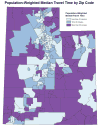Rural vs urban residence affects risk-appropriate colorectal cancer screening
- PMID: 23220166
- PMCID: PMC3615111
- DOI: 10.1016/j.cgh.2012.11.025
Rural vs urban residence affects risk-appropriate colorectal cancer screening
Abstract
Background & aims: Little is known about the effects of geographic factors, such as rural vs urban residence and travel time to colonoscopy providers, on risk-appropriate use of colorectal cancer (CRC) screening in the general population. We evaluated the effects of geographic factors on adherence to CRC screening and differences in screening use among familial risk groups.
Methods: We analyzed data from the 2010 Utah Behavior Risk Factor Surveillance System, which included state-added questions on familial CRC. By using multiple logistic regression models, we assessed the effects of rural vs urban residence, travel time to the nearest colonoscopy provider, and spatial accessibility of providers on adherence to risk-appropriate screening guidelines. Study participants (n = 4260) were respondents aged 50 to 75 years.
Results: Sixty-six percent of the sample adhered to risk-appropriate CRC screening guidelines, with significant differences between urban and rural residents (68% vs 57%, respectively; P < .001) across all familial risk groups. Rural residents were less likely than urban dwellers to be up-to-date with screening guidelines (multivariate odds ratio, 0.65; 95% confidence interval, 0.53-0.79). In the unadjusted analysis, rural vs urban residence (P < .001), travel time to the nearest colonoscopy provider (P = .003), and spatial accessibility of providers (P = .012) were associated significantly with adherence to screening guidelines. However, rural vs urban residence (P < .001) was the only geographic variable independently associated with screening adherence in the adjusted analyses.
Conclusions: There are marked disparities in use of risk-appropriate CRC screening between rural and urban residents in Utah. Differences in travel time to the nearest colonoscopy provider and spatial accessibility of providers did not account for the geographic variations observed in screening adherence.
Copyright © 2013 AGA Institute. Published by Elsevier Inc. All rights reserved.
Conflict of interest statement
Figures
Similar articles
-
Differences in Breast and Colorectal Cancer Screening Adherence Among Women Residing in Urban and Rural Communities in the United States.JAMA Netw Open. 2021 Oct 1;4(10):e2128000. doi: 10.1001/jamanetworkopen.2021.28000. JAMA Netw Open. 2021. PMID: 34605915 Free PMC article.
-
Predictors of Colorectal Cancer Screening: Does Rurality Play a Role?J Rural Health. 2015 Summer;31(3):254-68. doi: 10.1111/jrh.12104. Epub 2015 Jan 19. J Rural Health. 2015. PMID: 25599819
-
Rural-Urban Differences in Colorectal Cancer Screening Barriers in Nebraska.J Community Health. 2015 Dec;40(6):1065-74. doi: 10.1007/s10900-015-0032-2. J Community Health. 2015. PMID: 25910484 Free PMC article.
-
Rural-Urban Disparities in Colorectal Cancer Screening, Diagnosis, Treatment, and Survivorship Care: A Systematic Review and Meta-Analysis.Oncologist. 2024 Apr 4;29(4):e431-e446. doi: 10.1093/oncolo/oyad347. Oncologist. 2024. PMID: 38243853 Free PMC article.
-
Rural dwellers are less likely to survive cancer - An international review and meta-analysis.Health Place. 2018 Sep;53:219-227. doi: 10.1016/j.healthplace.2018.08.010. Epub 2018 Sep 5. Health Place. 2018. PMID: 30193178 Review.
Cited by
-
Impact of Alzheimer's disease and related dementias on colorectal cancer screening utilization, knowledge, and associated health disparities.Front Pharmacol. 2022 Sep 7;13:872702. doi: 10.3389/fphar.2022.872702. eCollection 2022. Front Pharmacol. 2022. PMID: 36160445 Free PMC article.
-
The impact of travel time on colorectal cancer stage at diagnosis in a privately insured population.BMC Health Serv Res. 2019 Mar 18;19(1):172. doi: 10.1186/s12913-019-4004-6. BMC Health Serv Res. 2019. PMID: 30885199 Free PMC article.
-
Multilevel Associations with Cancer Screening Among Women in Rural, Segregated Communities Within the Northeastern USA: a Mixed-Methods Study.J Cancer Educ. 2022 Dec;37(6):1982-1992. doi: 10.1007/s13187-021-02069-0. Epub 2021 Jul 15. J Cancer Educ. 2022. PMID: 34263433 Free PMC article.
-
Telehealth personalized cancer risk communication to motivate colonoscopy in relatives of patients with colorectal cancer: the family CARE Randomized controlled trial.J Clin Oncol. 2014 Mar 1;32(7):654-62. doi: 10.1200/JCO.2013.51.6765. Epub 2014 Jan 21. J Clin Oncol. 2014. PMID: 24449229 Free PMC article. Clinical Trial.
-
Physician recommendations and patient adherence after inadequate bowel preparation on screening colonoscopy.Dig Dis Sci. 2013 Aug;58(8):2151-5. doi: 10.1007/s10620-013-2642-9. Epub 2013 Mar 28. Dig Dis Sci. 2013. PMID: 23535876
References
-
- US Cancer Statistics Working Group. United States Cancer Statistics (USCS) 1999–2007 incidence and mortality data. Atlanta, GA: U.S. Department of Health and Human Services, Centers for Disease Control and Prevention, National Cancer Institute; 2010. [Accessed January 11, 2012.]. http://www.cdc.gov/uscs.
-
- US Preventive Services Task Force. Screening for colorectal cancer. Rockville, MD: Agency for Healthcare Research and Quality; 2008. [Accessed January 11, 2012]. http://www.uspreventiveservicestaskforce.org/uspstf/uspscolo.htm.
-
- MMWR. Colorectal cancer screening, incidence, and mortality United States, 2002–2010. Mor Mortal Wkly Rep. 2011;60(26):884–889. - PubMed
-
- Beydoun HA, Beydoun MA. Predictors of colorectal cancer screening behaviors among average-risk older adults in the United States. Cancer Causes Control. 2008;19:339–359. - PubMed
Publication types
MeSH terms
Grants and funding
LinkOut - more resources
Full Text Sources
Other Literature Sources
Medical



